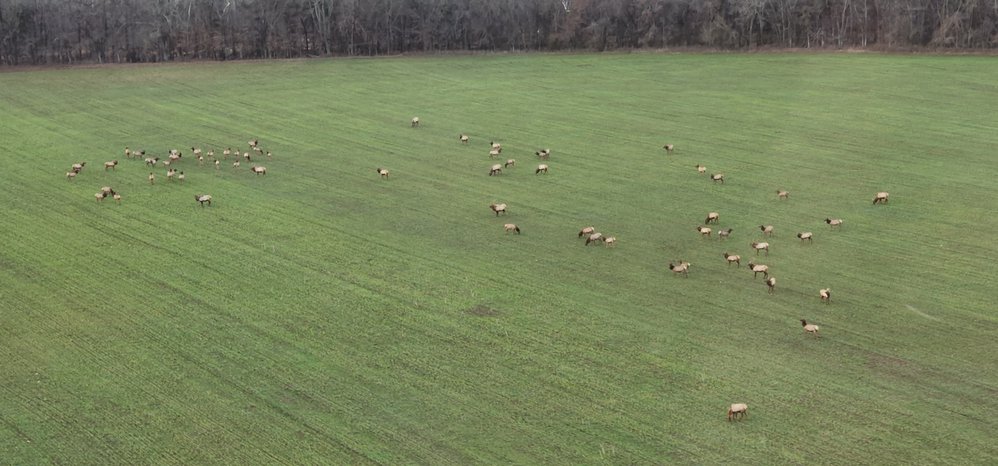Aerial surveys show slight increase in Arkansas elk population
BY agfc
ON 03-08-2023

March 8, 2023
JASPER — Arkansas Game and Fish Commission biologists took to the skies during the last two weeks to evaluate the status of Arkansas’s elk herd, and preliminary results indicate the population is again on the rise.
Wes Wright, elk program coordinator for the AGFC, said the initial tally of elk during the surveys was 419, which is about a 5 percent increase from last year.
“This is the first time in five years that we’ve seen an increase,” Wright said. There are likely a few more elk than that, but we base our decisions on trends in the minimum number of elk observed, which is what we are gathering in these surveys.”

Elk tend to form large herds that are concentrated on specific habitat types during the late winter. This habit and their large size makes them easier to spot, offering counts much closer to the actual population size than can be performed for other species, such as white-tailed deer.
Wright says the upturn is welcome news after five years of decreases following measures taken with elk management following the detection of chronic wasting disease in the herd.
“We increased quotas and encouraged more harvest following the initial detection of CWD,” Wright said. “At the same time, we saw added mortality from removing target elk that showed signs of the disease to help prevent its spread. We’ve now gone back to more conservative quotas and permit numbers to reduce harvest while still being able to remove any target elk should they be seen. Our surveys are a good opportunity to locate those sick elk as well because they’ll be by themselves instead of with the herds.”
In addition to the number of elk seen, biologists are evaluating the ratios of bull-to-cow elk and calves per cow seen.
“Historically, we see about 40 bulls per 100 cows and about the same ratio of calves to cows,” Wright said. “One calf per two adult cows is pretty typical of other states with elk populations.”
Wright says Arkansas’s bull-to-cow ratio falls a bit higher than many Western states that are traditionally known for elk hunting.

“That’s one of the objectives of the elk program, to provide a quality hunting experience,” Wright said. “Everyone wants to harvest a bull, and with the very limited draws and quotas we have in place, we’re able to regulate harvest very tightly to give hunters who draw a bull tag a very good chance at their bull on the limited amount of land available in our elk range.”
The AGFC has been conducting annual aerial surveys to monitor the population since 1991. The only years the flights were not conducted were 2014 and 2015, due to a lack of helicopter contractors available to pilot the survey.
While many smaller surveys are transitioning from plane and helicopter to unmanned aerial drones, these elk surveys continue to require the use of a helicopter.
“We’re covering such a large area in a short amount of time, and the terrain is very remote,” Wright said. “Most drones don’t have the range or speed needed to conduct this survey yet, but as the technology increases, it very well may be a viable option in the future.”
When in the air, Wright always tries to have one observer for each side of the helicopter, one being himself and the other being another wildlife biologist on staff. In some cases, the pilot has to fill in to be that extra set of eyes.
“We’ll fly over the large wildlife openings created for the elk on public ground and take our time counting,” Wright said. “We also will take pictures and video to double check our numbers later.” Wright credits the herd’s continued healthy numbers to continued habitat enhancements in Arkansas’s elk country. He says areas like Richland Valley on Gene Rush Wildlife Management Area and Bearcat Hollow WMA have exploded with elk since the initiation of large wildlife openings.

“We would see elk in these areas prior to habitat enhancement work, but many were just traveling through and not staying,” Wright said.
Since habitat work in Richland Valley began, Wright says he’s seen as many as 300 elk in one morning at that location. Bearcat Hollow has shown similar success.
“If you create that good habitat, they’re going to find it and use it,” Wright said. “And that helps keep the elk off of private land where we can run into nuisance issues.”
CUTLINES:
Aerial elk photo
Elk numbers have shown a slight increase during this year’s annual survey.
Inside helicopter
AGFC biologists have conducted aerial surveys for elk since 1991.
Outside helicopter
A helicopter is still the preferred survey tool in the rugged areas of Arkansas elk country.
Elk in field
Large wildlife openings attract elk on early spring mornings, which makes them easier to count from the air.
Recent News

Arkansas Wildlife Weekly Fishing Report
Jun. 26, 2025

2025-26 Federal Duck Stamp reveal Friday
Jun. 26, 2025
Subscribe to Our Weekly Newsletter E-mails
Don’t miss another issue. Sign up now to receive the AGFC Wildlife Weekly Newsletter in your mailbox every Wednesday afternoon (Waterfowl Reports are published weekly during waterfowl season and periodically outside the season). Fishing Reports arrive on Thursdays. Fill in the following fields and hit submit. Thanks, and welcome!
